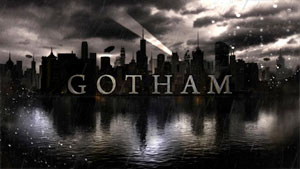“Gotham” (2014-19, Fox), which aired its final episode Thursday – and will likely draw more fans on Netflix in this age when shows are perpetually “new,” so I’ll discuss it in present tense — won’t be remembered as a top-shelf superhero franchise in this decade of superheroes. But I have to give it credit for being its own thing. It’s one of very few shows where if I hear someone say it’s horrible, and if I hear someone else say it’s great, I agree with both. Sometimes the quality wavers that much within one episode, and also, a lot depends on your mindset when tuning in.
Comfortable with what it is
I will say this for the “Batman” prequel series developed by Bruno Heller: It’s never uncomfortable with what it is. The craziness is always on purpose, from the set design that includes both modern and ancient technology to the arcs that send almost everyone (including the good guys!) in and out of prison … or at least the cells that are right there in the GCPD’s main office.
At first glance, you’d think “Gotham” is hampered by the time frame of Bruce Wayne’s (David Mazouz) teenage years. “Well, the villains can’t get too well-developed before he’s Batman,” one might think. But by the second season, it’s clear the writers don’t care about that: Almost all of the rogues gallery is in play.

“Gotham” (2014-19)
Network: Fox
Creator: Bruno Heller
Stars: Ben McKenzie, Donal Logue, David Mazouz
One exception is Two-Face (although Harvey Dent briefly appears in Season 1). To say the Joker (Cameron Monaghan) doesn’t appear until the series finale is semantics: Jeremiah Valeska is the Joker In Not-Named Only, and heck, his brother Jerome gets the ball rolling back in Season 1, back before his first death.
The Penguin (Robin Lord Taylor) and the Riddler (Cory Michael Smith) prance around, doing their thing, as early as the first season. Heller and his team got impatient waiting for Poison Ivy (Clare Foley) to grow up, so in Season 3 they invent some magic/scientific something-or-other that ages her into an adult. Then Ivy morphs again, from Maggie Geha into Peyton List. Because of this bizarre discontinuity, more so than any problems with the three individual performances, Poison Ivy is the rogue “Gotham” most whiffs on.
(Light Season 5 spoilers follow.)
Selina and Bruce stay in slow-burn mode
Selina Kyle (Camren Bicondova) and Bruce are ultimately the only cases of “Gotham” staying true to the slow-burn prequel aesthetic. The young actors play things close the vest, so by the time of the series finale, when Catwoman (now played by Lili Simmons) expresses that she had been crushed by Bruce departing for 10 years, I was like “Really?” Before that, there’s never enough of a sense that Selina likes Bruce all that much. Apparently there’s a thin line between love and perpetual annoyance.

One case where actors’ chemistry clicks, however, is between Ben McKenzie’s Jim Gordon and Crystal Reed’s Sofia Falcone in Season 3. The cop gets in deep emotionally with the crime boss, and this marks “Gotham” is at its best. Not that Lee Thompkins (Morena Baccarin) or Barbara Keane (Erin Richards) are hard to look at or have boring scenes with Jim, but Jim and Sofia sizzle. The arc ends with Sofia shot in the head, in a coma, obviously ready to come back at some point, since it’s that type of show. But she never does.
That’s one case where “Gotham’s” comic-book narrative approach hurts it. Unlike any other current TV show (except, arguably, the “X-Files” continuation), “Gotham” uses a narrative style where it moves the story forward a couple steps, then back a step, then forward a couple more steps – it tells pseudo-big stories without the impact on its characters being all that big. When it’s going bad, it won’t stay bad for long, but unfortunately the opposite also holds true, and Sofia’s arc is notably truncated.
The series finale serves up more of this storytelling-in-swirls: The Riddler holds the mayor captive and aims to blow up a building. Someone tells him this scheme seems familiar (because he had done it earlier in the series). Likewise, the scene of the heroes cutting the bomb’s wires follows the law of diminishing returns: It’s less tense than the 99th time we saw it, which was less tense than the 98th time, and so forth.
Does Bruce make much of a difference?
Long-running comic sagas like “Batman” double back and retell big moments all the time. So “Gotham” gets away with it if one uses the argument that it’s honoring the source medium. But one area where this approach doesn’t click is the overall arc of the titular city. In traditional “Batman” lore, Gotham has typical big-city issues, but the rise of a robust and dangerous crime network is a fairly new thing, so Batman emerges to challenge it. In “Gotham,” things are bad throughout Bruce’s youth, then they are bad again when he returns 10 years later in the finale.
Along with cop Bullock (Donal Logue) and Alfred (Sean Pertwee, as the most muscular version of Bruce’s butler/father figure), who is also the glue of “Gotham” as a whole, Jim Gordon fights the good fight, but Batman is supposed to be a difference-maker.
So it’s ironic that Gotham is at its best during the 10 years between the penultimate episode and the finale when Bruce is gone, the Joker is catatonic and the Penguin and Riddler are locked up. Bruce – who goes on a decade-long walkabout, presumably to further train to be Batman (although it’s unclear why he can’t do that in Gotham) – says he will return when the city needs him. That suggests the city is doing OK until just before he returns.
On the other hand, Selina is a cat burglar during this time when respectable jobs are theoretically available, and it seems the GCPD is plenty busy (although I admit that the years are not hard on Gordon and Bullock, who look the same as a decade prior). Overall, though, Gotham doesn’t seem to desperately need Batman; it needs to stop releasing its criminal masterminds from prison.
Lacking a specific point
By using the comic-book narrative strategy, “Gotham” doesn’t have a specific point any more than the 80 years of “Batman” comics have a specific point (and possibly less). It has a broad point: It’s cops fighting criminals. That’s not nothing when it’s done well – and it’s often done well in specific moments on “Gotham” – but it’s also dispiriting that we know Batman’s fight against crime and corruption will never end. And this closing statement gets delivered in the same week when the Marvel Cinematic Universe plays out its “Endgame.”
In this decade of superheroes, the MCU is the elite example of slick, carefully planned comic-book adaptations for the screen. A lesser example of that by-the-numbers style is the CW’s DC universe, with “Supergirl” and the like. The DC Cinematic Universe, meanwhile, tried to go full dark at first, but got rejected by critics and audiences and has since found success by mimicking the fun-loving MCU style – see “Shazam!”
There’s nothing else quite like “Gotham,” which is visually dark and broadly cares about honoring the source material … but ultimately doesn’t really care about the lore as much as it cares about Smith and Lord Taylor and Monaghan and Richards chewing the scenery in a dark camp answer to the 1960s “Batman’s” breezy camp.
Possible heirs to this style might be found to some degree in DC Universe shows such as “Titans” or “Doom Patrol.” Additionally, a “Pennyworth” Epix series will chronicle Alfred’s formative years after Pertwee’s steady-as-a-rock turn as Bruce’s surrogate father, and a new “Joker” movie will challenge Monaghan’s live-action stab at a Joker origin story.
Even if all these projects are great, one trait of “Gotham” works against the “Batman” and DC projects to follow. Because the villains are never defeated, spending time in the “Batman” universe is tiring, and fans have just finished an exhausting (if fun) five-year ride. We might need a breather.

